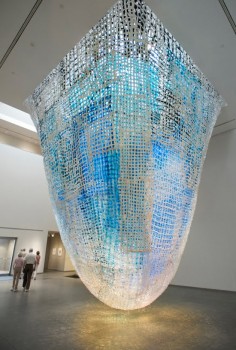Anna Hepler
The Great Haul
source: artinthestudio
I had only half an hour to run in for a look at Anna Hepler’s show “Makeshift” at the Portland Museum of Art (PMA) when I visited Maine a week or so ago. But that was long enough to enter the Museum’s Great Hall and be entranced by Hepler’s massive plastic web installed under the central skylight in the hall’s huge open space. What a magical display of light and volume she created from salvaged tarps and boat wraps! Her gathering skanky used tarps (without gloves or special clothing!) and boat wraps for the piece, then cutting the plastic into manageable hunks and then slicing those into strips that were sewn into latticed nets on sewing machines by Hepler and an assistant. When the piece was installed at the museum, nets were joined together by staples. If you go up close to the piece, you can see lengths of sewing thread in various colors sticking out from seams and adding a delicate extra dimension to the work. (If I had been taking the pictures, I would have taken one of this.) This was a gargantuan effort because the piece is 20 feet x 20 feet x 20 feet. Light falls into the piece from above but seems to emanate from inside the huge webs, which are actually double webs – blue inside and clear or white outside.
.
.
.
.
.
.
.
.
source: 2modern
Artist Anna Hepler breaks it all down into the perfect representation of form and leaves the viewer to ponder…which is exactly what every artist should do. Her 2D work evolves from her 3D sculpture that she constructs using various cast off pieces of plastic that are assembled and inflated. She then uses those structures as the spring board for her drawings, paintings and prints.
.
.
.
.
.
.
.
.
source: annahepler
During the past few years I have been making plastic, inflatable sculptures that slowly deflate and flatten. With these forms I observe transitions between two- and three-dimensional states, revel in both, and achieve neither. I am intrigued by the convergence of opposites evident in this work and the restlessness of the finished objects.
My prints and drawings evolve from these sculptures. The seams on my inflatables or the gestures and planes of my small ceramic forms map an intuitive process of decision-making. Later I fix those lines in prints, or photographs in order to honor the serendipitous nature of the original effort. I wonder then — am I getting closer to the center of things?


